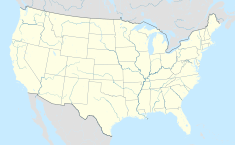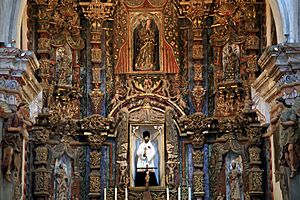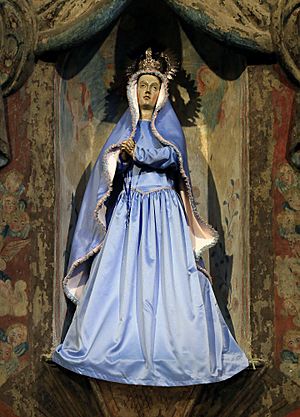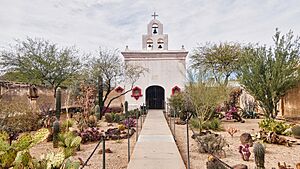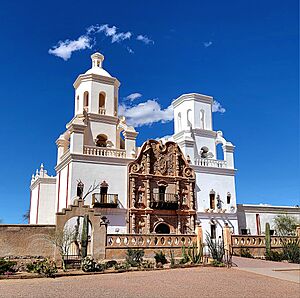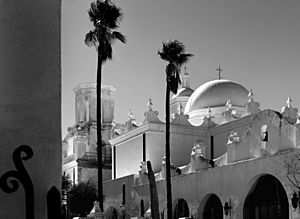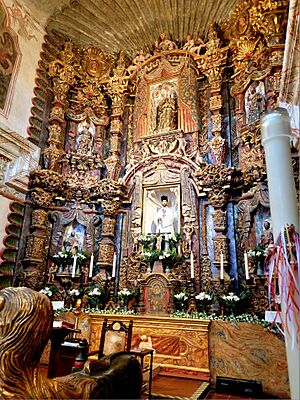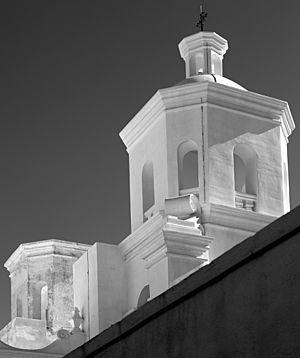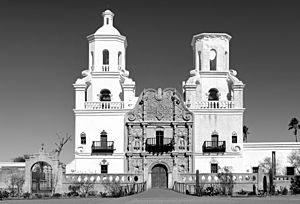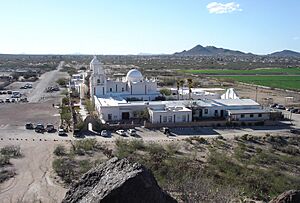Mission San Xavier del Bac facts for kids
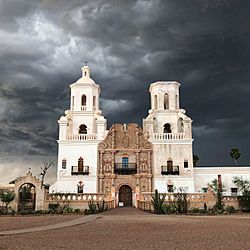
San Xavier del Bac
|
|
| Location | near Tucson, Arizona |
|---|---|
| Coordinates | 32°06′25″N 111°00′29″W / 32.107°N 111.008°W |
| Name as founded | La Misión San Xavier del Bac |
| English translation | The Mission of Saint Xavier of the Water |
| Patron | Saint Francis Xavier, SJ |
| Nickname(s) | "The White Dove of the Desert" |
| Founding date | 1692 (current structure dates to 1783–1797) |
| Founding priest(s) | Father Eusebio Francisco Kino, SJ |
| Native tribe(s) Spanish name(s) |
Tohono O'odhamans Yaqui |
| Governing body | San Xavier Indian Reservation |
| Current use | Parish Church |
| Designated | October 15, 1966 |
| Reference no. | 66000191 |
| Designated | October 9, 1960 |
Mission San Xavier del Bac is a famous Spanish Catholic mission located about 10 miles (16 km) south of Tucson, Arizona. It sits on the Tohono O'odham Nation San Xavier Indian Reservation. The mission was started in 1692 by Eusebio Kino. It was built in an area where the Sobaipuri O'odham people had lived for centuries.
The mission is named after Francis Xavier, who helped start the Jesuit Order. The first church was destroyed in 1770 during an Apache attack. The building you see today was rebuilt between 1783 and 1797. This makes it the oldest European structure in Arizona. The O'odham people did most of the work to build it.
Mission San Xavier del Bac is a beautiful example of Spanish Colonial architecture. About 200,000 people visit it every year. Many people also come here on a pilgrimage, sometimes on foot or horseback. The area is also called "Wa:k" in the O'odham language. This means "Water Place" because of the springs and surface water that used to flow there.
Contents
History of Mission San Xavier
Mission San Xavier del Bac was founded in 1692 by Eusebio Francisco Kino. He was a Jesuit priest from Italy who started many Spanish missions in the Sonoran Desert. He often visited and preached in this area, which was then part of New Spain.
Construction of the first church began on April 28, 1700. Father Kino wrote in his diary about the many people working with joy. They dug foundations and carried stones from a nearby hill. This first location was about 2 miles (3 km) from the current mission.
The mission faced attacks from the Apache. Because of these raids, construction was stopped for a while. It started again in 1756 under Alonso Ignacio Benito Espinosa. By 1763, the building was mostly finished, and services could be held inside.
In 1767, the King of Spain, Charles III of Spain, ordered all Jesuits to leave Spanish lands. Franciscan priests took their place. Francisco Garcés was sent to San Xavier del Bac. By 1770, Apache raids completely destroyed the original church. From 1775, the mission community was better protected by the Presidio San Agustín del Tucsón. This fort was built about 7 miles (11 km) away.
Building the Current Mission
The beautiful mission building we see today was built between 1783 and 1797. Franciscan fathers Juan Bautista Velderrain and Juan Bautista Llorenz led the project. They borrowed money and hired an architect named Ignacio Gaona. Many O'odham people worked hard to create this church.
After Mexico became independent from Spain in 1821, the mission was managed from Mexico City. In 1828, the Mexican government banned all Spanish-born priests. The last Franciscan priest left San Xavier in 1837.
Without priests, the mission started to fall apart. Local O'odham people tried to protect what they could. In 1852, a visitor named John Russell Bartlett described it as a "miserable place" with huts, but also the "largest and most beautiful church" in the region.
Becoming Part of the United States
In 1853, the Gadsden Purchase made San Xavier part of the United States. The church reopened in 1859 when the Santa Fe Diocese took over. They paid for repairs and sent a priest. In 1868, the Diocese of Tucson was created. This meant regular church services could happen again.
In 1872, the Sisters of St. Joseph started a school at the mission for Tohono O'odham children. More repairs were made in 1895, and new classrooms were added in 1900. The Franciscans returned to the mission in 1913. In 1947, they built a new school next to the church for local kids.
Renovation and Architecture
Big restoration work on the mission began in 1992 and is still happening today. This helps keep the old building in good shape.
San Xavier has a stunning white exterior with a Moorish-inspired look. Its entrance is beautifully decorated. When visitors step through the large, carved mesquite-wood doors, they often notice how cool it is inside. They are also amazed by the bright colors of the paintings, carvings, and statues. The building's style is completely European Baroque, without any Piman influence.
The church's layout looks like a classic Latin cross. It has a main aisle that leads to the sanctuary. A high dome, 52 feet (16 meters) tall, sits above the middle section. At least three different artists painted the artwork inside. Many people think it's the best example of Spanish mission architecture in the United States.
Mission San Xavier Today
Unlike other Spanish missions in Arizona, San Xavier is still an active church. Franciscan priests continue to run it and serve the local community who built it. It is open to the public every day, except when church services are happening. The Franciscan Sisters of Christian Charity still teach at the mission school, just as they have since 1872. The mission also has a special burial place, called a mausoleum, which visitors can see.
Mission San Xavier del Bac was named a National Historic Landmark in 1960. It was also added to the National Register of Historic Places in 1966. Every year, after Easter, the San Xavier Festival takes place. It includes a torch-light parade with members of the Tohono O'odham and Yaqui tribes.
See also
 In Spanish: Misión de San Xavier del Bac para niños
In Spanish: Misión de San Xavier del Bac para niños
- Spanish missions in Arizona
- Spanish Missions in the Sonoran Desert
- List of the oldest churches in the United States



